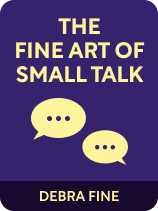

This article is an excerpt from the Shortform book guide to "The Fine Art of Small Talk" by Debra Fine. Shortform has the world's best summaries and analyses of books you should be reading.
Like this article? Sign up for a free trial here .
Do you know how to engage in small talk? What are the mechanics of a successful conversation? Should you prepare in advance?
In her book The Fine Art of Small Talk, Debra Fine breaks down all of the components of a successful conversation. She gives you advice for questions and answers you should prepare in advance, how to actively listen, cues to give your partner, and how to speak assertively.
Here are Debra Fine’s tips on how to hold a successful conversation.
Prepare General Questions
Sometimes, if it’s particularly important to have a successful conversation, you might want to prepare for it in advance. Let’s explore how to prepare conversational topics and personal anecdotes.
When you anticipate talking to new people, Fine says, prepare specific questions in advance about the person (or people) you want to meet, the event, or the situation. You can use these questions to revitalize a flagging conversation by creating a new topic to follow up on.
Here are some examples of the kinds of questions you can prepare in advance:
- What’s your favorite way to relax after work?
- What do you like about [open mic night, Amber’s parties, the Smithsonian]?
- Have you ever been to [a protest, a seminar, a meetup] like this before?
- Are you from around here? Are there any local events I should know about?
(Shortform note: It’s arguably crucial to prepare questions that show interest in people’s thoughts and opinions because it makes them feel good. When you really listen to people, they feel important, interesting, and valuable—as a result, they’ll be happy to talk more! This is partly why, as Dale Carnegie points out, you make friends much more easily by being interested in them than by trying to get them interested in you.)
Prepare Personal Anecdotes
Even if you’ve prepared many questions about the other person, the author says, to have a successful conversation you’ll eventually have to talk about yourself. You can share your feelings, your opinions about books, restaurants, and movies, or your memories of events and experiences. According to Fine, people will resent it if the conversation isn’t balanced, so you need to share as much as you receive. Furthermore, when you talk about yourself, you give others the opportunity to feel connected to you, give them a new topic to speak about, and allow them to share their own related experiences.
(Shortform note: In direct contrast to Fine’s advice, many experts suggest you avoid talking about yourself too much. When you don’t talk about yourself, they say, you listen better—you’re not busy thinking about what to say next. Furthermore, you ask more questions and pay more attention to the answers. To determine whether you need to talk about yourself less or more, ask yourself: Do you already talk about yourself in most conversations? If so, try not talking about yourself for the next two days. If, however, you typically avoid talking about yourself, follow Fine’s suggestions below and try to do so more often.)
How to Listen Actively
Another key to a great conversation, according to the author, is listening actively. Fine describes active listening as an ongoing process in which you listen fully to the speaker’s message and validate their words by giving visual and verbal feedback.
(Shortform note: To validate, in this case, means to support the speaker by showing them you understand and accept their message. In short, you’re letting them know you’ve not only heard what they’re saying, but that you’ve taken it to heart. Note that you don’t have to agree with someone’s point to validate it; just don’t ignore, reject, or judge them for sharing it.)
She also mentions a third component to active listening: engaging mentally and staying focused on the speaker.
In concert, the three components make you a better listener—you’ll make others feel heard, so they’ll actively seek you out for conversation, company, and support. Let’s look at each component in detail.
Give Your Partner Visual Cues
Fine explains that when you listen to someone, you should use your body language to communicate your interest and engagement. Here’s how:
1. Act as if there were no distractions in the room. Fine suggests you face your partner openly and directly and smile.
(Shortform note: Fine’s recommendation here may not always be advisable: Some people don’t appreciate physical directness. They may be anxious, have different physical boundaries, or prefer a more gentle, relaxed communication style. Allow others to set their own boundaries without taking offense.)
2. Nod, make eye contact, and stay focused on the speaker. If you have trouble maintaining eye contact, Fine suggests you look at the space between their eyes instead of directly at them; your partner won’t be able to tell the difference.
(Shortform note: What Fine suggests regarding eye contact is generally applicable in the United States, but note that it may not be appropriate when you interact with people from different backgrounds. In some places, it’s considered aggressive to gaze constantly and directly into another’s eyes.)
3. Be aware of what your body language implies. Don’t cross your arms and legs, place your hands on your hips, or rest your chin in your hand. Don’t fidget or keep your head down. Fine notes that these signs are typically interpreted as implying boredom, disinterest, disagreement, or hostility.
(Shortform note: Fine is arguably being a little unfair here since the examples she provides don’t necessarily communicate boredom or disinterest. You may actually fidget because you’re anxious, uncomfortable, or nervous. If you’re worried your fidgeting may be sending the wrong message, practice hiding those nerves. Furthermore, a therapist can help you practice body language that communicates the messages you want to send.)
Give Your Partner Verbal Cues
Verbal cues, Fine explains, add to the reassurance provided by visual cues. Verbally indicating that you’re present and aware encourages your partner to keep speaking.
Fine notes that you can use verbal cues to show you understand, agree, disagree, or want to hear more. For example, you can say: “Hmm, I see…” “What makes you feel that way?”
You can also use verbal cues to transition to another topic. For example, you can say: “That reminds me: I’ve heard that… What do you think about that?” or “Since you’re an engineer, I wonder if you could explain…”
(Shortform note: Like the visual cues we display through our body language, the purpose of verbal cues is to inform your partner that you’re still listening, that you’re still interested, and that you’d like them to continue speaking. In short, you’re giving encouragement and reassurance. If you have trouble seeing the value in this, imagine you’re describing your symptoms to a doctor and she just sits there, staring at you, until you finish. That would be disconcerting! Instead, you’d likely prefer if she nodded along, hummed thoughtfully, and occasionally asked elaborating questions, like, “..and how long has this been going on?”)
One helpful verbal cue is to paraphrase and repeat, the author suggests. This technique lets you clarify that you understood the other person correctly, or helps them recognize where you misunderstood what they were trying to say.
Here are some common ways to paraphrase and repeat:
- “Wait, you mean he actually said that he doesn’t care what you think?”
- “So, it’s the left outlet you want me to plug it into?”
- “Sir, I just want to be sure: You’re asking me to order seven thousand copies?”
(Shortform note: The goal of paraphrasing and repeating is not just to parrot in the way Fine describes—it’s also to ensure you understand what’s being said in the spirit in which it’s intended. You’re remembering the speaker’s points, asking about them, and clarifying your understanding because it helps you connect with the speaker. You’re giving them the comfort of knowing they’re understood.)
The Mental Component of Listening
Finally, remember that giving visual and verbal cues that suggest you’re listening isn’t enough: You have to actually listen, too. Listening is your job in the conversation, Fine argues, and it isn’t optional.
(Shortform note: It’s not easy to listen with your full attention, as Fine suggests. Research shows we think much faster than we speak—so when we’re just listening to someone speak, our brains have plenty of time to get distracted. If you find your mind often wanders while others are meandering through a sentence, try keeping your brain engaged by focusing on more than just the speaker’s words: Watch their body language—their face, eyes, posture, and tone of voice—can you tell how they feel about the topic? Weigh the evidence of their points; is the logic sound? Think ahead, and try to guess where the speaker’s thought is going. Finally, review the highlights of the conversation so far.)
How to Speak Assertively
Now that you know how to listen, let’s explore how Fine recommends you speak: not passively, but assertively. According to Fine, the words and phrasing you use communicate a lot about your self-image. She argues that when you use passive language, you imply that you’re unreliable, subservient, or incompetent.
Consider the following dialogue between April and her coworker, Jeff:
- April: Hi Jeff, can I ask you a question? I wanted to ask if you’ll have those client reports for me soon.
- Jeff: I’ll have to check with my boss, but I’ll try and get them to you this week.
There are a number of issues here. First, there’s no need for April to ask if she can ask a question; she comes across as if she’s bowing and scraping. When she does ask her question, it’s vague, and it doesn’t specify the urgency of her need.
Jeff, meanwhile, by using the phrase “have to,” implies that April’s request is an imposition that forces him to take on an additional burden. When he says he’ll “try,” he gives the impression that he’s uncertain about his ability to fulfill her request in the timeframe he specifies, and implies that he’s making room for himself to wriggle out of the commitment.
Meanwhile, Fine argues that speaking assertively gives the impression that you know what you want and need. It also commands attention.
Consider the following dialogue, in which both parties are direct and assertive:
- April: Hi Jeff, I need those client reports by next weekend. Can I expect them by the end of the week?
- Jeff: I’ll get in touch with my boss and make sure you have them by Friday.
Here, April clearly communicates her need and the timeframe she’s expecting. She gets straight to the point. Jeff, too, is clear about his plan of action, letting April know what he’s doing and when she can expect her request to be fulfilled. Both parties come across as confident professionals who are sure of their needs and capabilities.
| Aggressive, Passive, or Assertive? While Fine discusses the need to be assertive, she doesn’t cover why people may be reluctant to do so. Often, people who avoid assertive language and act passively instead do so because they worry it makes them look aggressive—but that’s a misunderstanding. You can be assertive without being aggressive. Psychologists tell us that the difference between being aggressive, passive, or assertive is a matter of who you put first and how you communicate your needs. An aggressive person puts himself first. He demands and enforces the fulfillment of his own needs and desires, often at the cost of the needs, desires, and boundaries of others. In many cases, an aggressive person uses threats, disrespect, or verbal abuse to get his way. He wants his client reports now, and he doesn’t care whose day he ruins to get them. In direct contrast, a passive person puts everyone else first. He allows the needs and desires of others to supersede his own, and doesn’t act to protect his boundaries. As a result, he often “ends up” in situations where he’s uncomfortable, unhappy, or unsatisfied. As Fine notes, passive people don’t make a strong impression; they belittle their own views, skills, and knowledge, seek the approval of others, and are constantly apologetic. A passive person would rather give up control over when he gets his client reports than step on anyone’s toes. Assertiveness is the middle ground between passiveness and aggressiveness. An assertive person is respectful of both her own needs and those of the other party. She communicates her needs clearly, in whatever way is most effective; she doesn’t scream when it’s inappropriate and doesn’t bow when it’s unnecessary. She sets her own boundaries and defends them without violating the boundaries of others. In short, if she needs those client reports by Tuesday, she says so. If there’s a problem preventing that, she’ll adjust—but everyone involved knows what her needs, goals, and expectations are. |

———End of Preview———
Like what you just read? Read the rest of the world's best book summary and analysis of Debra Fine's "The Fine Art of Small Talk" at Shortform .
Here's what you'll find in our full The Fine Art of Small Talk summary :
- Why we need small talk and why we shouldn't avoid it
- How to appear confident and engaging in any context
- How to break the ice with strangers and keep the conversation going






